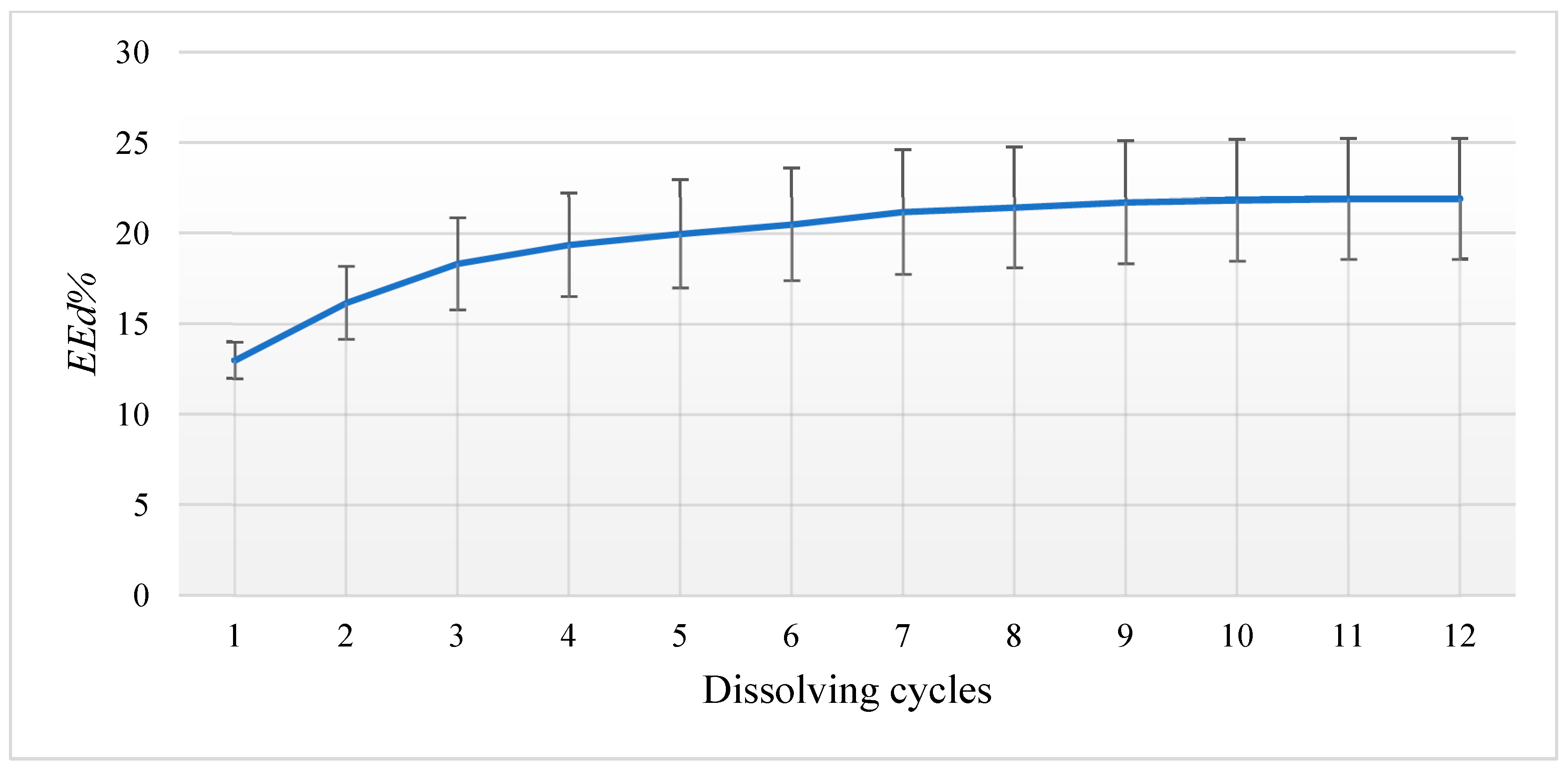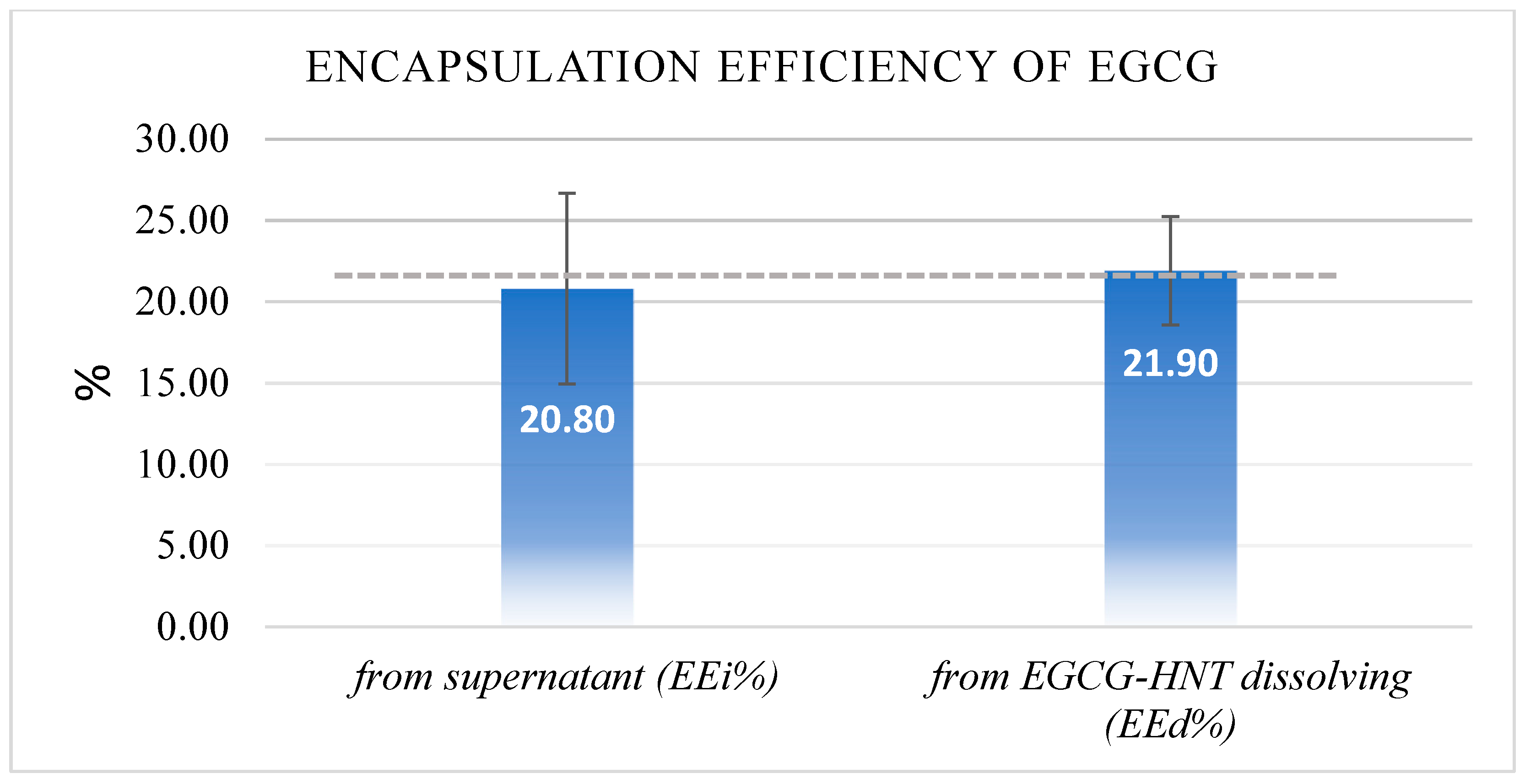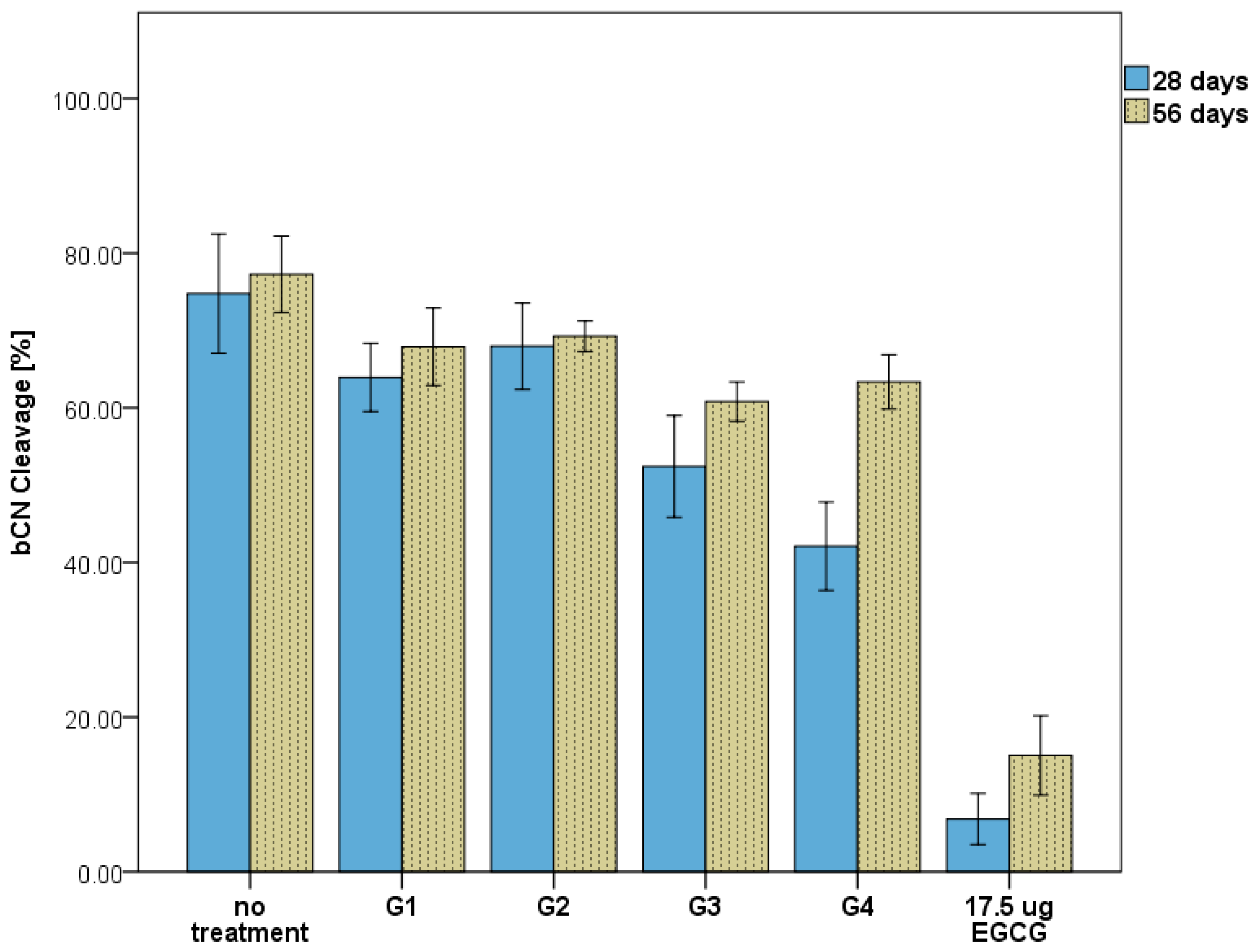Release and MMP-9 Inhibition Assessment of Dental Adhesive Modified with EGCG-Encapsulated Halloysite Nanotubes
Abstract
1. Introduction
2. Materials and Methods
2.1. EGCG Encapsulation
2.2. Determining Drug Encapsulation Efficiency
2.3. Adhesive Specimen Preparation
2.4. EGCG Release Analysis Using UV-Vis
2.5. MMP-Mediated β-Casein Cleavage Assays
2.6. Statistical Analysis
3. Results
3.1. Drug Loading and Unloading Analysis
3.2. EGCG Release Analysis Using UV-Vis
3.3. MMP-Mediated β-Casein Cleavage Assays
4. Discussion
Author Contributions
Funding
Institutional Review Board Statement
Informed Consent Statement
Data Availability Statement
Acknowledgments
Conflicts of Interest
References
- Spencer, P.; Ye, Q.; Park, J.; Topp, E.M.; Misra, A.; Marangos, O.; Wang, Y.; Bohaty, B.S.; Singh, V.; Sene, F. Adhesive/dentin interface: The weak link in the composite restoration. Ann. Biomed. Eng. 2010, 38, 1989–2003. [Google Scholar] [CrossRef] [PubMed]
- Maske, T.; Kuper, N.; Hollanders, A.; Bronkhorst, E.; Cenci, M.; Huysmans, M. Secondary caries development and the role of a matrix metalloproteinase inhibitor: A clinical in situ study. J. Dent. 2018, 71, 49–53. [Google Scholar] [CrossRef] [PubMed]
- Breschi, L.; Maravic, T.; Cunha, S.R.; Comba, A.; Cadenaro, M.; Tjäderhane, L.; Pashley, D.H.; Tay, F.R.; Mazzoni, A. Dentin bonding systems: From dentin collagen structure to bond preservation and clinical applications. Dent. Mater. 2018, 34, 78–96. [Google Scholar] [CrossRef]
- Pashley, D.H.; Tay, F.; Yiu, C.; Hashimoto, M.; Breschi, L.; Carvalho, R.; Ito, S. Collagen degradation by host-derived enzymes during aging. J. Dent. Res. 2004, 83, 216–221. [Google Scholar] [CrossRef]
- Tjäderhane, L.; Larjava, H.; Sorsa, T.; Uitto, V.-J.; Larmas, M.; Salo, T. The activation and function of host matrix metalloproteinases in dentin matrix breakdown in caries lesions. J. Dent. Res. 1998, 77, 1622–1629. [Google Scholar] [CrossRef] [PubMed]
- Chaussain-Miller, C.; Fioretti, F.; Goldberg, M.; Menashi, S. The role of matrix metalloproteinases (MMPs) in human caries. J. Dent. Res. 2006, 85, 22–32. [Google Scholar] [CrossRef]
- Brantley, C.F.; Bader, J.D.; Shugars, D.A.; Nesbit, S.P. Does the cycle of rerestoration lead to larger restorations? J. Am. Dent. Assoc. 1995, 126, 1407–1413. [Google Scholar] [CrossRef]
- Kopperud, S.E.; Tveit, A.B.; Gaarden, T.; Sandvik, L.; Espelid, I. Longevity of posterior dental restorations and reasons for failure. Eur. J. Oral Sci. 2012, 120, 539–548. [Google Scholar] [CrossRef]
- Van Wart, H.E.; Birkedal-Hansen, H. The cysteine switch: A principle of regulation of metalloproteinase activity with potential applicability to the entire matrix metalloproteinase gene family. Proc. Natl. Acad. Sci. USA 1990, 87, 5578–5582. [Google Scholar] [CrossRef]
- Birkedal-Hansen, H.; Moore, W.; Bodden, M.; Windsor, L.; Birkedal-Hansen, B.; Decarlo, A.; Engler, J. Matrix metalloproteinases: A review. Crit. Rev. Oral Biol. Med. 1993, 4, 197–250. [Google Scholar] [CrossRef]
- Visse, R.; Nagase, H. Matrix metalloproteinases and tissue inhibitors of metalloproteinases: Structure, function, and biochemistry. Circ. Res. 2003, 92, 827–839. [Google Scholar] [CrossRef]
- Mazzoni, A.; Pashley, D.H.; Nishitani, Y.; Breschi, L.; Mannello, F.; Tjäderhane, L.; Toledano, M.; Pashley, E.L.; Tay, F.R. Reactivation of inactivated endogenous proteolytic activities in phosphoric acid-etched dentine by etch-and-rinse adhesives. Biomaterials 2006, 27, 4470–4476. [Google Scholar] [CrossRef] [PubMed]
- Tay, F.R.; Pashley, D.H.; Loushine, R.J.; Weller, R.N.; Monticelli, F.; Osorio, R. Self-etching adhesives increase collagenolytic activity in radicular dentin. J. Endod. 2006, 32, 862–868. [Google Scholar] [CrossRef] [PubMed]
- Almahdy, A.; Koller, G.; Sauro, S.; Bartsch, J.; Sherriff, M.; Watson, T.; Banerjee, A. Effects of MMP inhibitors incorporated within dental adhesives. J. Dent. Res. 2012, 91, 605–611. [Google Scholar] [CrossRef]
- Ferrazzano, G.F.; Amato, I.; Ingenito, A.; Zarrelli, A.; Pinto, G.; Pollio, A. Plant polyphenols and their anti-cariogenic properties: A review. Molecules 2011, 16, 1486–1507. [Google Scholar] [CrossRef]
- Bai, L.; Takagi, S.; Ando, T.; Yoneyama, H.; Ito, K.; Mizugai, H.; Isogai, E. Antimicrobial activity of tea catechin against canine oral bacteria and the functional mechanisms. J. Vet. Med. Sci. 2016, 78, 1439–1445. [Google Scholar] [CrossRef] [PubMed]
- Madhan, B.; Krishnamoorthy, G.; Rao, J.R.; Nair, B.U. Role of green tea polyphenols in the inhibition of collagenolytic activity by collagenase. Int. J. Biol. Macromol. 2007, 41, 16–22. [Google Scholar] [CrossRef] [PubMed]
- Kim-Park, W.K.; Allam, E.S.; Palasuk, J.; Kowolik, M.; Park, K.K.; Windsor, L.J. Green tea catechin inhibits the activity and neutrophil release of Matrix Metalloproteinase-9. J. Tradit. Complement. Med. 2016, 6, 343–346. [Google Scholar] [CrossRef]
- Chowdhury, A.; Nandy, S.K.; Sarkar, J.; Chakraborti, T.; Chakraborti, S. Inhibition of pro-/active MMP-2 by green tea catechins and prediction of their interaction by molecular docking studies. Mol. Cell. Biochem. 2017, 427, 111–122. [Google Scholar] [CrossRef]
- Djerir, D.; Iddir, M.; Bourgault, S.; Lamy, S.; Annabi, B. Biophysical evidence for differential gallated green tea catechins binding to membrane type-1 matrix metalloproteinase and its interactors. Biophys. Chem. 2018, 234, 34–41. [Google Scholar] [CrossRef]
- Du, X.; Huang, X.; Huang, C.; Wang, Y.; Zhang, Y. Epigallocatechin-3-gallate (EGCG) enhances the therapeutic activity of a dental adhesive. J. Dent. 2012, 40, 485–492. [Google Scholar] [CrossRef] [PubMed]
- Neri, J.R.; Yamauti, M.; Feitosa, V.P.; Pires, A.P.M.; Araújo, R.D.S.; Santiago, S.L. Physicochemical properties of a methacrylate-based dental adhesive incorporated with epigallocatechin-3-gallate. Braz. Dent. J. 2014, 25, 528–531. [Google Scholar] [CrossRef]
- Khamverdi, Z.; Rezaei-Soufi, L.; Rostamzadeh, T. The effect of epigallocatechin gallate on the dentin bond durability of two self-etch adhesives. J. Dent. 2015, 16, 68. [Google Scholar]
- Yu, H.; Zhang, L.; Yu, F.; Zhou, H.; Shen, L.; Chen, J. Effects of epigallocatechin-3-gallate modification on the bonding stability of an etch-and-rinse adhesive to intraradicular dentin. Chin. J. Stomatol. 2017, 52, 114–119. [Google Scholar]
- De Macedo, F.a.A.; Souza, N.O.; Lemos, M.V.S.; De-Paula, D.M.; Santiago, S.L.; Feitosa, V.P. Dentin bonding and physicochemical properties of adhesives incorporated with epigallocatechin-3-gallate. Odontology 2019, 107, 23–28. [Google Scholar] [CrossRef]
- Fonseca, B.M.; Barcellos, D.C.; Silva, T.M.D.; Borges, A.L.S.; Cavalcanti, B.D.N.; Prakki, A.; Oliveira, H.P.M.D.; Gonçalves, S.E.D.P. Mechanical-physicochemical properties and biocompatibility of catechin-incorporated adhesive resins. J. Appl. Oral Sci. 2019, 27, e2018011. [Google Scholar] [CrossRef] [PubMed]
- Bottino, M.C.; Batarseh, G.; Palasuk, J.; Alkatheeri, M.S.; Windsor, L.J.; Platt, J.A. Nanotube-modified dentin adhesive—Physicochemical and dentin bonding characterizations. Dent. Mater. 2013, 29, 1158–1165. [Google Scholar] [CrossRef] [PubMed]
- Lvov, Y.; Wang, W.; Zhang, L.; Fakhrullin, R. Halloysite clay nanotubes for loading and sustained release of functional compounds. Adv. Mater. 2016, 28, 1227–1250. [Google Scholar] [CrossRef]
- Atomssa, T.; Gholap, A. Characterization and determination of catechins in green tea leaves using UV-visible spectrometer. J. Eng. Technol. Res. 2015, 7, 22–31. [Google Scholar]
- Windsor, L.J.; Steele, D.L.; Leblanc, S.B.; Taylor, K.B. Catalytic domain comparisons of human fibroblast-type collagenase, stromelysin-1, and matrilysin. Biochim. Et Biophys. Acta (BBA) Gen. Subj. 1997, 1334, 261–272. [Google Scholar] [CrossRef]
- Dobrinas, S.; Soceanu, A.; Popescu, V.; Stanciu, G.; Smalberger, S. Optimization of a UV-VIS spectrometric method for caffeine analysis in tea, coffee and other beverages. Sci. Study Res. Chem. Chem. Eng. Biotechnol. Food Ind. 2013, 14, 71. [Google Scholar]
- Radhakrishnan, R.; Kulhari, H.; Pooja, D.; Gudem, S.; Bhargava, S.; Shukla, R.; Sistla, R. Encapsulation of biophenolic phytochemical EGCG within lipid nanoparticles enhances its stability and cytotoxicity against cancer. Chem. Phys. Lipids 2016, 198, 51–60. [Google Scholar] [CrossRef] [PubMed]
- Palasuk, J.; Windsor, L.J.; Platt, J.A.; Lvov, Y.; Geraldeli, S.; Bottino, M.C. Doxycycline-loaded nanotube-modified adhesives inhibit MMP in a dose-dependent fashion. Clin. Oral Investig. 2018, 22, 1243–1252. [Google Scholar] [CrossRef] [PubMed]
- Veerabadran, N.G.; Price, R.R.; Lvov, Y.M. Clay nanotubes for encapsulation and sustained release of drugs. Nano 2007, 2, 115–120. [Google Scholar] [CrossRef]
- Fields, G.B.; Netzel-Arnett, S.J.; Windsor, L.J.; Engler, J.A.; Birkedal-Hansen, H.; Van Wart, H.E. Proteolytic activities of human fibroblast collagenase: Hydrolysis of a broad range of substrates at a single active site. Biochemistry 1990, 29, 6670–6677. [Google Scholar] [CrossRef] [PubMed]
- Windsor, L.J.; Steele, D.L. Expression of recombinant matrix metalloproteinases in Escherichia coli. Methods Mol. Biol. (Clifton NJ) 2010, 622, 67–81. [Google Scholar]
- Yasumitsu, H.; Ozeki, Y.; Kanaly, R.A. RAMA casein zymography: Time-saving and highly sensitive casein zymography for MMP7 and trypsin. Electrophoresis 2016, 37, 2959–2962. [Google Scholar] [CrossRef]
- Gilles, A.-M.; Keil, B. Cleavage of β-casein by collagenases from Achromobacter iophagus and Clostridium histolyticum. FEBS Lett. 1976, 65, 369–372. [Google Scholar] [CrossRef] [PubMed]
- Snoek-Van Beurden, P.A.; Von Den Hoff, J.W. Zymographic techniques for the analysis of matrix metalloproteinases and their inhibitors. Biotechniques 2005, 38, 73–83. [Google Scholar] [CrossRef] [PubMed]
- Huo, C.; Wan, S.; Lam, W.; Li, L.; Wang, Z.; Landis-Piwowar, K.; Chen, D.; Dou, Q.; Chan, T. The challenge of developing green tea polyphenols as therapeutic agents. Inflammopharmacology 2008, 16, 248–252. [Google Scholar] [CrossRef]
- Ortiz, J.; Ferruzzi, M.; Taylor, L.; Mauer, L. Interaction of environmental moisture with powdered green tea formulations: Effect on catechin chemical stability. J. Agric. Food Chem. 2008, 56, 4068–4077. [Google Scholar] [CrossRef] [PubMed]
- Li, N.; Taylor, L.S.; Ferruzzi, M.G.; Mauer, L.J. Kinetic study of catechin stability: Effects of pH, concentration, and temperature. J. Agric. Food Chem. 2012, 60, 12531–12539. [Google Scholar] [CrossRef]
- Li, N.; Taylor, L.S.; Mauer, L.J. Degradation kinetics of catechins in green tea powder: Effects of temperature and relative humidity. J. Agric. Food Chem. 2011, 59, 6082–6090. [Google Scholar] [CrossRef] [PubMed]
- Zimeri, J.; Tong, C. Degradation Kinetics of (−)-Epigallocatechin Gallate as a Function of pH and Dissolved Oxygen in a Liquid Model System. J. Food Sci. 1999, 64, 753–758. [Google Scholar]




| Adhesive Group | Adhesive (mL) | HNT (mg) | EGCG (mg) | Final EGCG Concentration (mg/mL) | |
|---|---|---|---|---|---|
| G1 | Control adhesive | 5 | - | - | 0 |
| G2 | 7.5% HNT | 5 | 375 | - | 0 |
| G3 | 7.5% HNT-0.15% EGCG | 5 | 375 | 37.5 mg (~8.0 mg *) | 1.6 |
| G4 | 0.15% EGCG | 5 | - | 8.0 mg | 1.6 |
| Group | 1 Day | 7 Days | 14 Days | 28 Days | 56 Days | |
|---|---|---|---|---|---|---|
| G3 7.5% HNT-0.15% EGCG | Mean | 1.07 a | 1.63 a | 2.23 a | 2.95 a | 3.71 a |
| SD | 0.24 | 0.36 | 0.51 | 0.88 | 1.01 | |
| G4 0.15% EGCG | Mean | 2.85 b | 3.97 b | 4.77 b | 5.54 b | 6.18 b |
| SD | 0.14 | 0.14 | 0.12 | 0.31 | 0.76 |
| Group | bCN Cleavage % (SD) | bCN Cleavage Rate (μM/h) (SD) | ||
|---|---|---|---|---|
| 28 Days | 56 Days | 28 Days | 56 Days | |
| blank | 74.76 (7.70) a | 77.26 (4.94) a | 33.40 (7.43) a | 37.29 (5.55) a |
| G1 (Control adhesive) | 63.92 (4.40) a,b | 67.90 (5.00) a,b | 33.11 (7.00) a | 30.83 (3.42) a,b,c |
| G2 (7.5% HNT) | 67.96 (5.59) a,b | 69.26 (1.96) a,b | 34.45 (4.09) a | 32.52 (1.48) a,b |
| G3 (7.5% HNT-EGCG) | 52.42 (6.57) b,c | 60.80 (2.54) b | 16.59 (4.68) b | 21.64 (2.63) c |
| G4 (0.15% EGCG) | 42.09 (5.71) c | 63.35 (3.52) b | 16.07 (4.99) b | 26.92 (4.75) b,c |
| 17.5 ug EGCG | 6.83 (3.30) d | 15.04 (5.13) c | 1.30 (2.24) c | 1.71 (2.63) d |
Disclaimer/Publisher’s Note: The statements, opinions and data contained in all publications are solely those of the individual author(s) and contributor(s) and not of MDPI and/or the editor(s). MDPI and/or the editor(s) disclaim responsibility for any injury to people or property resulting from any ideas, methods, instructions or products referred to in the content. |
© 2023 by the authors. Licensee MDPI, Basel, Switzerland. This article is an open access article distributed under the terms and conditions of the Creative Commons Attribution (CC BY) license (https://creativecommons.org/licenses/by/4.0/).
Share and Cite
Alhijji, S.; Platt, J.A.; Alhotan, A.; Labban, N.; Bottino, M.C.; Windsor, L.J. Release and MMP-9 Inhibition Assessment of Dental Adhesive Modified with EGCG-Encapsulated Halloysite Nanotubes. Nanomaterials 2023, 13, 999. https://doi.org/10.3390/nano13060999
Alhijji S, Platt JA, Alhotan A, Labban N, Bottino MC, Windsor LJ. Release and MMP-9 Inhibition Assessment of Dental Adhesive Modified with EGCG-Encapsulated Halloysite Nanotubes. Nanomaterials. 2023; 13(6):999. https://doi.org/10.3390/nano13060999
Chicago/Turabian StyleAlhijji, Saleh, Jeffrey A. Platt, Abdulaziz Alhotan, Nawaf Labban, Marco C. Bottino, and L. Jack Windsor. 2023. "Release and MMP-9 Inhibition Assessment of Dental Adhesive Modified with EGCG-Encapsulated Halloysite Nanotubes" Nanomaterials 13, no. 6: 999. https://doi.org/10.3390/nano13060999
APA StyleAlhijji, S., Platt, J. A., Alhotan, A., Labban, N., Bottino, M. C., & Windsor, L. J. (2023). Release and MMP-9 Inhibition Assessment of Dental Adhesive Modified with EGCG-Encapsulated Halloysite Nanotubes. Nanomaterials, 13(6), 999. https://doi.org/10.3390/nano13060999








